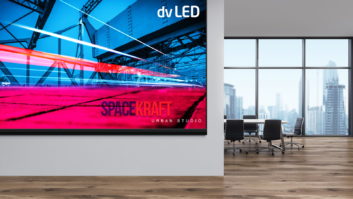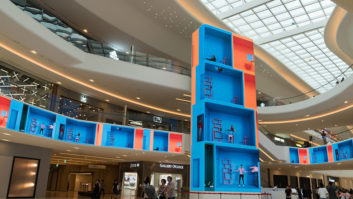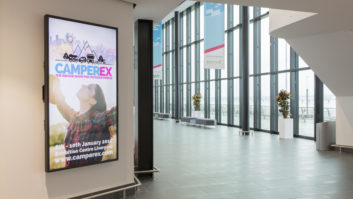It is possible to ascribe the meteoric growth in the digital signage market to a number of factors. Competition among retailers, the need to ‘engage’ buyers rather than just talk at them, and the numerous case studies showing digital signage delivering real, measurable return on investment are just a few. In a buoyant market, though, no one has been talking about price. Until now.
ISE 2009 saw what seemed to be a plethora of new, lower-priced digital signage solutions. It was no illusion. “Yes, we’ve launched an entry-level player,” says Frederik Vroman, business development manager at Belgium-based digital signage company dZine. “The aim wasn’t to lower the price in the market of our products, but to allow novice customers who have no experience in digital signage solutions to start working with our turnkey package at an attractive price. Our plan is that, in time, we’ll be able to upsell them to other products in our range.”
“The barrier to entry has dropped considerably,” notes Jason Cremins, chief executive officer of remotemedia, the company behind signagelive, the SaaS (Software as a Service) web-based digital signage platform. “The main factors are the availability of lower cost display technology with integrated PC technology from our distributor Midwich; coupled with platforms such as signagelive that have no upfront costs to set up servers and communications networks, and that have zero on-site set-up requirements.”
Ian McKenzie, chief executive officer of Dynamax Technologies, agrees. “As digital signage markets grow and develop, the cost of the technologies involved will inevitably decrease,” he says. “This perpetual progress makes entering the industry today, and in the future, a much easier feat, despite the increased competition. New entrants are benefiting from improved technology, higher levels of integration, and industry innovations, not to mention the lower costs of network components. The logical consequence of such expansion and improvement is reduced costs to end clients.”
“Digital signage is definitely getting cheaper,” says David Oades, managing director of digital signage company Sedao. “We expect growth of well over 50% in the coming year. The main reason for this is the expanded use of large-format LCD – which are reducing dramatically in price – and the maturity of the market.”
“As a company, we expect to see growth in our traditional areas of education, government and health care, not just because the government is continuing to plough money into these areas but because in these sectors digital signage really works,” he continues. “Whether you have several thousand employees or a couple of thousand pupils, the communication challenge is the same, and a well-deployed digital signage network solves their problems. Five years ago, many businesses wouldn’t have been able to afford it, but now they can. We’ve just provided digital signage to an independent chain of bookmakers and even an independent butcher. Only a few years ago they simply couldn’t have contemplated the expense.”
“The cost of entry into the digital signage market has been decreasing over time,” adds Hugh Bourne, product marketing manager for digital signage, EMEA, at Harris. “There are many reasons for this, including the fact that hardware costs are now lower. Previously, in order to have a media player that was capable of playing back HD video content, the hardware needed to be of a high specification. Nowadays, those same specifications are relatively inexpensive, as the technology has moved on to ever faster platforms at the higher end of the spectrum.”
And that’s a key distinction, made by several in the industry. There is no real price pressure on mid- and high-end digital signage solutions: rather, the functionality and flexibility of those solutions is being improved, offering more capability for a similar price.
“C-nario has recently announced C-Sign, a system for the small and medium-sized business market,” notes the company’s vice president of marketing, Yael Elstein. “We’re seeing increasing demand for simple entry-level packaged solutions that include hardware and software at a reasonable price. For high-end projects, though, there’s no decrease in prices.”
It’s not just from the supply side, however, that prices are being driven down. Maturity in the digital signage market means that customers are increasingly knowledgeable about what they do and don’t want – a point made by Pierre Gillet, vice president of European sales at Roku. “Customers have an excellent understanding of exactly what a digital signage solution can do for them,” he says. “They know which features and functions they require to achieve their marketing objectives. They are favouring vendors that offer them the right solution for the right price and are unwilling to pay for features they don’t need.”
“As more features appear as standard,” adds Iain Campbell, sales and marketing director at Midwich sister company True Colours Distribution, “the likelihood of customisation becomes less. This can create the impression that the cost of the system is coming down.”
Two sides to the market
The current state of the market, however, gives some manufacturers and integrators cause for concern. There is some evidence of commoditisation, the price of entry is low and the market is growing – which is likely to see a flood of new entrants. “As always, when there are new markets with potential, a lot of newcomers will try to get a slice of the cake,” observes Daniel Quitzau, sales manager for Mitsubishi Electric in Sweden. “But in the end the ones that aren’t good enough will fade away and the quality products will remain.”
Oades is equally concerned about what he sees as the digital signage market becoming more accessible. “Every week, we have to decline new dealers who have the attitude ‘I don’t want to know about it – I just want to sell it’,” he says. “But as inexpensive as digital signage solutions have become, there is still no substitute for fully understanding the requirement. If integrators find products that fit their market and their customers, and understand those products and customers well, then even when prices drop, they’ll profit. They’ll still be part of a solution that is solving a real customer need, and they will be well placed to serve that customer’s other AV needs later.”
For Bourne, understanding the customer’s true requirement is of paramount importance. “We find that when customers who plan on growing their networks start to look at all of the options, they will frequently choose a feature-rich solution that is highly scalable,” he says. “Very often, starting with a low-end player results in customer frustration when they find that to implement some of the features they are looking for further down the line requires additional investment.”
Diluted sector
There’s also concern about the potential for damage to the reputation of digital signage as a technology and as a solution. “Today, a lot of cheap player products are being thrown into the market that are mostly advanced video players accompanied by some basic software for content distribution,” says Vroman. “These are being positioned and marketed as turnkey ‘digital signage solutions’ which they emphatically are not.”
And is their quality up to the standard necessary? Albert Tromp, marketing manager for Mitsubishi in the Netherlands, is worried. “There are dangers in evaluating digital signage products on the ex-works price tag alone,” he says. “Experience has shown that performance and build quality are critical factors in keeping the total cost of ownership to a minimum, and so these are the most important considerations for us. A cheap screen that goes wrong after three months achieves nothing.” Mitsubishi has recently announced a partnership in Benelux with C-nario that will see the two companies jointly offering complete solutions.
Lowering prices in the digital signage market isn’t necessarily unalloyed good news then. Beyond that, there’s the inevitable squeeze on margins and profitability. For Cremins, the answer lies in the margins available on software – which will typically be greater than those on hardware – and from ongoing revenue streams.
Campbell is in agreement. “Integrators will offer services and content as a revenue stream, and distributors will start to offer more services for the resellers to sell,” he says. “Then there’s the opportunity provided by innovative products like TruMedia that can be used to evaluate return on investment. The data from TruMedia can be used to tailor content according to the demographics of an audience.”
David Dalzell, managing director of ONELAN, picks up the theme of innovation, noting the potential sophistication of digital signage solutions, and the need to market and sell them appropriately. “Take our Touch & Contact Closure capability,” he says. “That enables a Net Top Box to become fully interactive. Now, instead of the content being refined to part of a day or a location, it can be refined to an individual customer who can be automatically invited to find the precise information he needs.”
“Lower entry pricing and improved value across the board will play a part in expanding the use of digital signage,” says Gillet. “Lower cost platforms that are easy to install and require little or no maintenance are already taking digital signage into small and medium-sized businesses and applications where previously they were uneconomic. At the same time, new features such as greater interactivity and live video support are encouraging high-end users to extend their use of the technology – perhaps even to renew their existing estates.”
“In reality, the general decrease in digital signage costs has more to do with the fact that developers and manufacturers are listening more closely to their customers’ needs,” notes McKenzie. “If a customer requires the full complexity of an enterprise solution, he’s still better advised to invest at the higher end, as opposed to simply running a couple of screens without plans to grow. This approach helps end users deliver digital signage without initial heavy investment; they now have the opportunity to first evaluate their return on investment.”
It is hard to escape the feeling that the digital signage market continues to be a strong one and that, for the most part, it is being strengthened by new levels of price/performance across the board. The customer need is no less pressing, even if budgets are tighter. For the integrator prepared to understand the requirement, the digital signage opportunity is a compelling one – and it’s still there.







